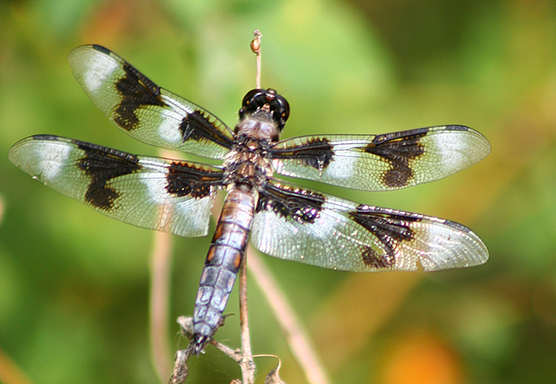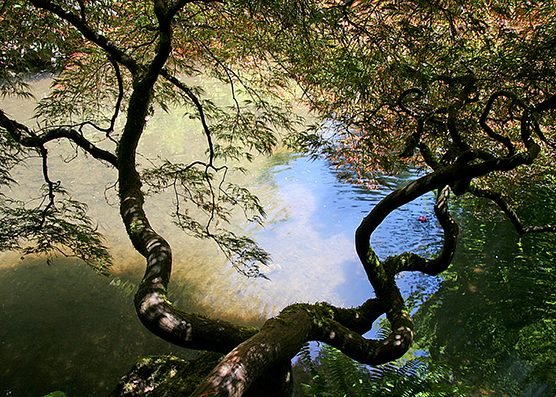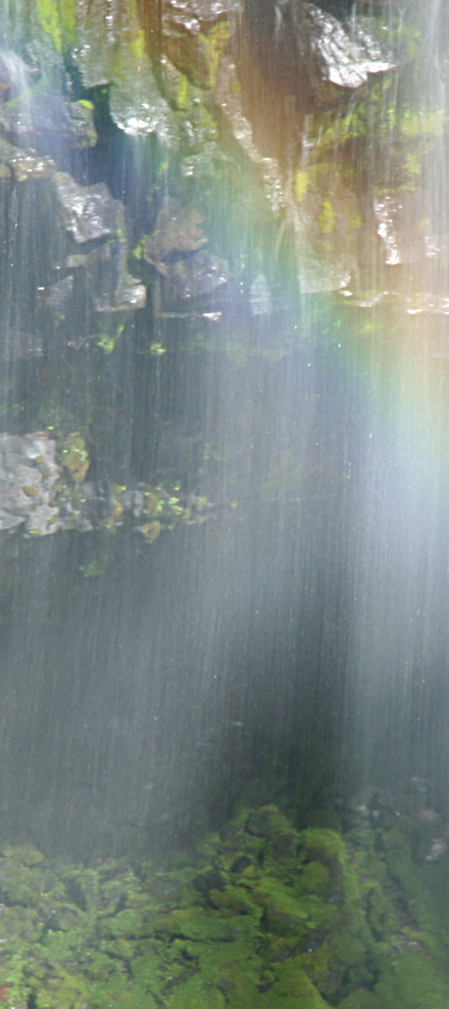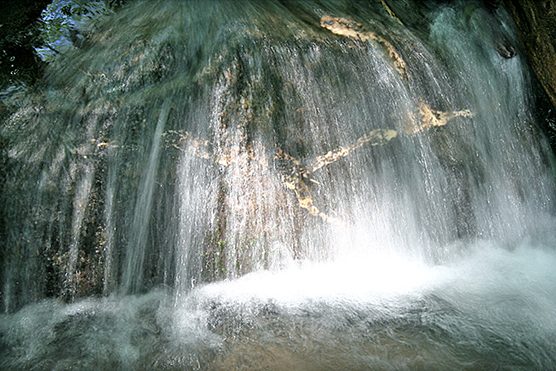Abiding in Non-Duality
Vibrate in stillness. Overflow with
emptiness. Become single
and feel everything.
Beyond Blessing
A blessing is an experience, an event that takes place in time and has a beginning, a middle and an end. Repeated blessings eventually lead to blessedness—uninterrupted communion with the divine, whether this power is called God, Brahman, the Holy Spirit, the Divine Mother, the Tao, the luminous void, our original nature or heart. In the beginning, blessedness is often intermittent; still in the realm of experience, it comes and goes. Later, blessedness becomes stable and constant. When the spiritual journey culminates in “enlightenment” or “union with God,” it is impossible to leave this all-embracing, lucid consciousness.
Blessedness, as I define it, is characterized by non-dual awareness. The person who embodies this kind of awareness perceives the world without the dualistic categories that structure ordinary perception—categories like me/you, us/them, good/bad, God/human, body/soul, teacher/student and animal/human. Instead, they perceive the fundamental unity underlying the multiple forms that make up our world and the categories that structure our perception of it. These many forms and designations, which previously seemed separate or even mutually exclusive, now appear to be harmoniously related or essentially indistinguishable from one another.
I first associated blessedness with non-duality while reading Michael Washburn’s book, The Ego and the Dynamic Ground. In chapter eight, he explains that during blessedness individuals experience “hot” and “cold” affective states simultaneously: they feel delight, radiant happiness, and overflowing joie de vivre on the one hand and composure, quiet clarity and profound gratitude on the other. The paradoxical result is “serene joy,” “glowing gratitude” and “calm exuberance.” In other words, during blessedness pairs of opposites meet.
From within this unitive awareness—this synthesis of contraries—individuals realize that what once appeared to be distinct, and perhaps opposed, is, in fact, contained within a single, larger whole. The underlying reality that unites the myriad forms now comes into view.
A metaphor may be helpful here. Imagine a leafy plant growing in a placid lake. The plant’s roots, its stalk and two branching stems are all underwater; above the water, only two leafed stems are visible. To an observer viewing the plant from shore, it appears that two separate plants are growing side by side. This observer might even imagine that the two plants are opposed—competing for space and resources. If she would only dive beneath the surface, however, she would find that the two plants are one.
This shift in perspective (from above the water’s surface to below it) represents the movement from dualistic to unitive awareness. When we are immersed in the living waters of our divine nature, the unity behind the diversity of life becomes palpable. In other words, when we enter the realm of blessedness the invisible root, common to the world’s many forms, is revealed.
For this perceptual shift to take place, we must quiet our thoughts enough to enter heart’s domain; symbolically speaking, we have to “get wet.” Mental stillness is required because the mind habitually thinks in dualisms—categories that divide the world into “me and not-me.” Only when our thoughts quiet down and we enter heart’s love-stream can the dualistic categories of the mind fall away. Resting in our true nature, we see the world through “heart’s eyes”—as a unity.*
Dancing in Non-Duality
On February 20, 1981, when my spontaneous meditative experiences began, I glimpsed the unity behind the myriad forms of our world. Although I lacked the vocabulary to describe my experiences then, I know now that on that date I began to touch the non-dual realm.
From the beginning, I realized that opposites were meeting during my private spontaneous experiences. Dualities that I’d assumed to be “givens”—inherent in the nature of things—began to merge. For many years, I’d believed that polarities like God/human, body/soul and personal God/impersonal Power were opposites and always mutually exclusive. But once heart became active inside me, I realized that divine energy was flooding my humanness and my soul was prompting my body into physical movements. In addition, I was encountering a sacred inner current that seemed to be both a personal presence (the experience of many Christians) and an impersonal force (experienced by practitioners in a number of earth-based and Eastern religions).
Soon I was exploring what I now call “the invisible ground of sympathy,” to borrow a Taoist term for the non-dual realm. According to Taoist philosopher Chung-yuan Chang, when spiritual seekers become submerged in Tao, the primordial source of all, they enter the great sympathy. Sometimes called Tz’u, the great sympathy is the invisible root of all love and compassion and the essential moving force behind the universe. When, through quietude or intuitive knowledge, an individual enters this realm, the boundaries between multiplicities fall away so that subject and object, self and non-self, “interfuse.” No longer an individual enclosed by a shell of separateness, the seeker now identifies with other beings. Through direct experience, she knows that her self and the selves of others not only interpenetrate but also share the same root.
There were many signs that I had begun to touch the ground of sympathy, the meeting place of opposites. When my heart-led gestures were lyrical and flowing, I looked like a woman, but when heart prompted me to thrust and jab like a martial arts practitioner, I moved like a man. Sometimes the vocalizations of animals, especially birds, poured spontaneously from my human lips. Often, I embodied the movements and sounds of religions that are considered distinct—even opposed.
All of these visible and audible expressions arose from and deepened my mental stillness. They did not disturb it, as some spiritual teachers suggest. I watched with wonder as countless forms arose from my silent, single-minded meditation on heart.
There were other signs that I had entered the ground of sympathy. While surrendering to God with the understanding of an adult, I sometimes regressed to infancy, making me an elder and a child—both at once. I was guided first to reenact the movements and sounds of my wounded inner child, then to make the assured motions and babblings of a self-confident infant. Led by heart, I served not only as the healee, but also as the healer, restoring a troubled child to life.
Once I began teaching spontaneous meditation, I discovered that the roles of “teacher” and “student” often faded when we entered heart’s silence together. Our “beingness” became more important—more tangible and more obvious—than our social roles. In the mysterious dance that emerged between us, laughter and playful behavior sometimes arose in the midst of our serious spiritual practice. In addition, I found that the more I was true to heart during meditation, carefully following its promptings, the more authentic and full was the rapport that developed between me and other meditators. Being true to myself enhanced, rather than disrupted, my connection with others.
During these early years of spiritual teaching, I occasionally enrolled as a trainee in art-based personal growth practices. I watched as a number of my colleagues struggled to decide whether to work with clients through images, words, sounds or movements. Guided by heart, I did not have to make this decision. When heart flowed inside me, it brought forth a myriad of divine forms—songs, spoken thoughts, gestures, dance movements and periods of silent sitting—to help us grow and transform.
The ground of sympathy was perhaps most evident when students and I shared experiences of body and sensory awareness. A meeting with my first student, Susan, provides an example. One day, we were moving in silent spontaneity around her living room when I heard with my inner ear, “Shout out the name of God!” Since I hadn’t been thinking of God’s name, I assumed that this instruction was meant for Susan. At the same time, I was new to this process and didn’t completely trust my hearing, so I didn’t speak the instruction aloud. Later in the session, Susan yelled out a string of words I didn’t understand. After meditation, she explained that during her enthusiastic outburst she had spoken her guru’s name.
Another sympathetic experience unfolded with June, a young woman who liked to keep to herself during spontaneous meditation sessions. We always started out talking amiably, but each time we went into the silence, she would retreat to a corner of the room. Matching her mood, heart always guided me to another location, giving her ample space. This pattern went on for perhaps six sessions.
As we began the seventh, heart immediately and unambiguously led me to within a few inches of her body. It then prompted me to gesture and vocalize in her energy field. This was so unusual, I kept checking to be sure my impulses were coming from my true self and not from my mind. When the timer rang ending our meditation, she explained what had happened: “Before coming to the session today, I told the universe that I wanted to experience heart directly through your movements and sounds. Your being must have heard my request.”
My most unusual shared experience of the ground of sympathy occurred with Kate, a woman I met at an Expressive Arts training. In the summer of 1990, Kate was suffering from pleurisy—a painful inflammation of the lining of the lung. Having experienced my spontaneous movements previously, she asked me to “dance her lungs” so she could observe my gestures. Assuming Kate wanted me to help make visible the energy blockages in her chest, I quieted my mind, opened to heart and focused on her lungs. Suddenly, I began gulping in large quantities of air through my mouth; at the same time a hoarse, rattling sound came from the back of my throat. While this noisy breathing continued, my arms flew around my upper torso, vigorously rubbing and brushing my skin as they went. After three or four minutes, my breathing calmed and my arms fell still at my sides. When I raised my head up to look at Kate, we stared at each other, wide-eyed with surprise.
My sense during this unusual process had been that the movements heart was guiding me to make on my chest were helping Kate to heal. When she spoke, Kate described her own experience with lightness in her voice: “While you were dancing, the pain in my chest turned into tingling sensations, then disappeared. It’s still gone—even now.” When I checked with Kate later that day and the next, her symptoms had not returned.
When Kate and I met, our goal was to help her heal somehow. Following intuition, we found ourselves—without consciously intending to—standing together on the invisible ground of sympathy. While we inhabited this non-dual realm, movements performed on my body helped restore Kate’s lungs to health.
When Action Becomes Egoless
For a long time, I thought of these varied experiences as separate tastes of heart’s non-dual nature; I didn’t think of spontaneous meditation—the practice itself—as non-dual. Then one day I came upon a book by philosopher David Loy, called Nonduality. Through his writing, I came to understand that spontaneous meditation not only enables us to see through heart’s eyes but also trains us to engage in non-dual action.
In order to explain this unusual kind of action, I’ll begin with an ancient story recounted by Professor Loy. This tale, originally told by Chuang Tzu—the famous Chinese Taoist from the fourth century BCE—goes as follows.
In the royal court of Prince Lu, a carpenter named Ching carved a stand to hold musical instruments. Observers—even the prince himself—saw in it something supernatural. When the prince asked the carpenter how he had achieved this mystical quality, Ching answered that while there was no mystery at work, still there was something….
To explain this mysterious “something,” Ching then described how he prepared himself to carve the wood. First, to guard against the lessening of his vital power, he quieted his mind for three days until he had no desire for reward. After two days, he no longer identified with his body. At that point, he stopped entertaining any thoughts of the royal court and his skill became focused. Only then did he bring his own natural capacity into relation with the essence of the wood and begin to carve.
In this story we see several elements of non-dual action. Ching the carpenter, like other explorers in the non-dual realm, begins by quieting his mind and releasing his expectations: all striving after success and reward is given up. As Loy observes, quiescence supports and enables his intention-less activity because the pursuit of goals requires mental calculation (“doing x will produce y”). When he gives up mental activity, the carpenter undoes the fundamental structure of striving. With his mind quiet and his self-centered calculations suspended, Ching’s limited personality, his ego-self, dissolves, at least for a time. No longer preoccupied with self-serving intentions, the carpenter now watches his true nature—the Indwelling Tao—enter into relation with the true nature of the wood he is to carve. The result (all be it unintended!) is an artistic creation in which the Tao, the ineffable source of all, becomes visible.
Non-dual action, then, takes place when the mind is still and the person is goal-less—without intention or aspiration. While all mental constructs and expectations are in abeyance, the individual “self” ceases to function, enabling the person to enter the Tao’s non-dual realm. Now his or her essence may interfuse with other essences, merging even with the Tao-nature of a piece of wood.
Ching’s story describes his preparation for non-dual action, but he stops short of explaining what happens while he carves the music stand. Loy fills in the gap, explaining that non-dual action is spontaneous, effortless and natural. By this he means that no arbitrary, willful effort is made. Non-dual action is natural because there is no “pushing against” involved—no struggle with either an internal part of the self or an external other.
Instead, the non-dual actor follows her Te—the Indwelling Tao. While resting in this interior source—the ground of her being—she follows its promptings. No individual “I” is present or needed to direct the action. In other words, the person’s impetus for movement in the world arises not from her ego-self but from heart, the reality that transcends individuality and exists everywhere. No action by an individual “doer” takes place. The person is simply an instrument for the universal consciousness that all forms share.
In Taoism, this way of moving through life is called wu-wei, the “action of non-action.” During action-less action, the person does nothing—or at least as little as possible. Resting in heart’s silence, she waits until a thought, an insight or a gesture arises from the ground of being, then she enacts this transcendent directive.
Action-less action is not limited to Taoism, of course. In the West, Christianity is, at its core, a non-dual religion. When Jesus proclaimed, “I and the Father are One” (John 10:30), he invited his followers into non-dual consciousness—a state of awareness in which Creator and created abide in one another. In the Gospel of Thomas (Saying 25), Jesus explained that to enter God’s Kingdom our understanding must be unified: we must make the two into one, the inner like the outer, the upper like the lower, and male and female into a single one.**
When Jesus advised, “Love your neighbor as yourself.” (Mark 12:31), he asked his disciples to relate to one another in a non-dual way. As scholar Cynthia Bourgeault explains, this means that we are to love our neighbor not as much as ourselves but as ourselves, realizing that we each arise from and return to the same ground of being.
In Saying 77 of the Gospel of Thomas, Jesus described his full identification with God to his followers, saying, “I am the light over all things. I am all. From me all has come forth, and to me all has reached.” Then he made a statement strikingly reminiscent of Ching’s relationship with wood. He declared, “Split a piece of wood. I am there.”
Elsewhere in the Gospel of Thomas (Saying 50), Jesus told his disciples: “If they ask you, ‘What is the evidence of your father in you?’ say to them, ‘It is motion and rest.’” This curious statement makes sense when we remember that during non-dual action, the distinction between motion and rest fades away. The individual remains aware of an unchanging, still center while participating in life’s flux. She is able to work without effort, accomplishing much while doing nothing.
Spontaneous Meditation as Non-Dual Action

The kind of spontaneous meditation that I practice fosters these elements of non-dual action. This discipline:
- calls us into mental stillness;
- encourages us to release expectations while meditating;
- facilitates direct experience of heart, our divine nature;
- loosens the grip of the conditioned ego; and
- encourages us to let heart become the “doer” of our spiritual practice.
If we return to the video on this website—and to the thoughts expressed in the poem, Spontaneous Meditation is a Way—we’ll see that these characteristics of non-duality have been present all along.
On silence: Believing that the mind must be quiet in order to directly experience the God within, spontaneous meditators set aside exercises—procedures directed by thought. We focus, instead, on the self we find in the silence—on heart, our sacred love-nature. (From Poem sections 2 and 7)
On goal-seeking: Before turning within, we let go of the idea that meditation must solve problems, transmit information or create good health. We remember that the outcome of spiritual practice is uncertain, for heart streams uniquely within each of us, transforming unseen obstacles, calling forth unexpected talents. Knowing that heart cannot be controlled or predicted, wanting to share in love’s blessing, we are willing to be surprised. (Poem sections 2 and 8)
On direct experience: During meditation, we attend to love—not emotional love or loving behavior, but the presence, energy or consciousness that dwells within each of us. While resting in the silence, we practice finding and feeling this love-center within. We learn to recognize the sensations of heart as they arise in our bodies—to feel its rushes, tingles and pulls. (Poem sections 2 and 3)
On the ego: During this practice, we meet lost parts of our personalities, including those we experience as “not-love.” Whenever we encounter unhappy memories, we cleanse them in the river of love. This we do by simultaneously feeling our heart and our hurt, our love and our “not-love.” Then we offer our hurt to heart, which enables them to meet. When these two parts of us touch, painful sensations change form: either they turn into new sensations or they simply disappear. (Poem sections 4 and 5)
In time, our blessings deepen. Then we watch “not-love” dissolve in love; we watch our hearts grow. (Poem section 6)
We also release our talents, habits, pleasures and joys into heart’s fluid light. We offer everything so that nothing stands between us and love. (Poem section 6)
On heart as the “doer”: Having quieted our minds and given ourselves to our divine nature, we wait. If heart prompts us to twirl or sway, we move; if heart directs us to sit quietly, we hold still. The more we follow heart, the more love flows within us, bringing unimaginable gifts that are our birthright. (Poem sections 3 and 7)
While remaining in the silence, we watch love’s river move between us, streaming from heart to heart, amplifying the sensations of being within each meditator. We watch our circle of blessings flow. (Poem section 7)
While in the silence, then, we spontaneous meditators practice feeling heart and taking action—both at once. By “taking action,” I mean that we allow heart to guide us into movements and sounds of its own choosing—expressions that sometimes engage other meditators.
In this way, spontaneous meditation prepares us to rest in silent awareness while participating in ordinary life. Eventually, we learn that the pairs, movement/stillness, meditation/work and spirituality/intimacy, need not be “opposed” but can exist peacefully together.
In 1998, I sketched the first draft of a poem, hoping to capture something of heart’s non-dual nature. I began by recalling my own mystical experiences, then I changed perspective and used the voice of our true self to describe them. In these lines, heart invites us not only to abide in non-duality during meditation but also to experience blessedness—unitive awareness—in daily life.
The Flowing Rock
I am your original nature.
Some say I’m like a flowing rock
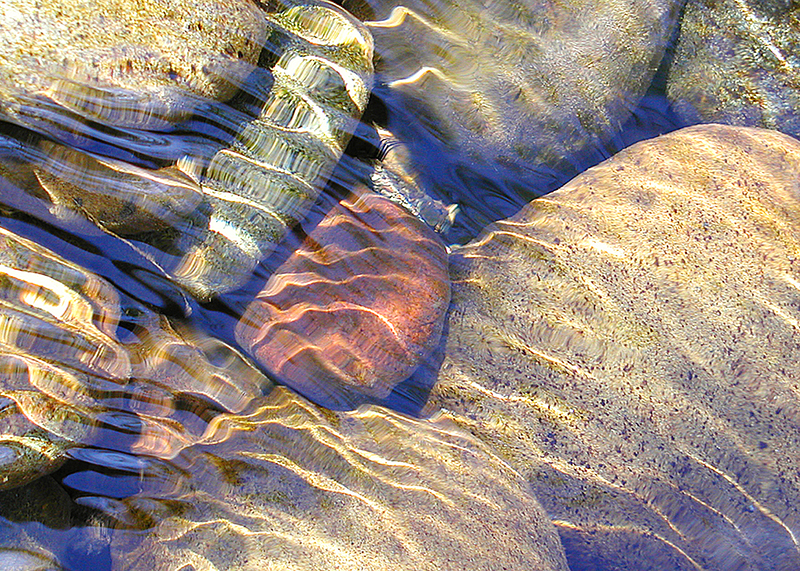 for I have no opposite.
for I have no opposite.
In me all contraries meet.
I am both female and male:
moving and resting,
soothing and piercing,
dissolving and revealing.
I am spirit permeating flesh,
life embracing death,
silence containing thought,
love welcoming fear.
I am still when I move.
When I speak I am silent.
I play when I’m disciplined.
When I laugh I am serious.
I am the elder who is just born
and the sage who is ignorant,
the healer that is wounded
and the leader that is led.
My self-containment fosters closeness.
I heal through images and by touch.
Offering words sounds and movements,
my gifts are all one.
The songs of nuns and shamans are mine.
The postures of priests and yogis are mine.
The rituals of gurus and rabbis are mine.
Rest in me, I am your home.
The cawing of crows and jays will be yours.
The hissing of geese and snakes will be yours.
The roaring of winds and waves will be yours.
Dwell in me, I am your home.
Your impulse will be your neighbor’s need.
Your word will be your neighbor’s thought.
His sound will be your forgotten cry.
Her gesture will heal your long-held pain.
Vibrate in stillness.
Overflow with emptiness.
Become single and feel everything.
Return to the life of the flowing rock.
Notes
* The history of religious mysticism is filled with accounts of unitive awareness. Since there is not enough space to list them all here, I offer a few of my favorites. For a good overview of non-duality in Asian religions, see David Loy’s Nonduality. In Creativity and Taoism, Chang Chung-yuan offers a Taoist description of the “invisible ground of sympathy.” Compilations of dialogues with Ramana Maharshi (in books like David Godman’s Be As You Are) portray the experience of non-duality from the point of view of a Hindu sage. For a classic discussion of unitive consciousness in the West, see Evelyn Underhill’s Mysticism. For a modern understanding of non-dual Christianity, I suggest the works of minister-scholar, Cynthia Bourgeault. In Everything is God, Jay Michaelson provides a Jewish perspective.
** Lines from the Gospel of Thomas are from Essential Gnostic Scriptures, edited and translated by Willis Barnstone and Marvin Meyer.


